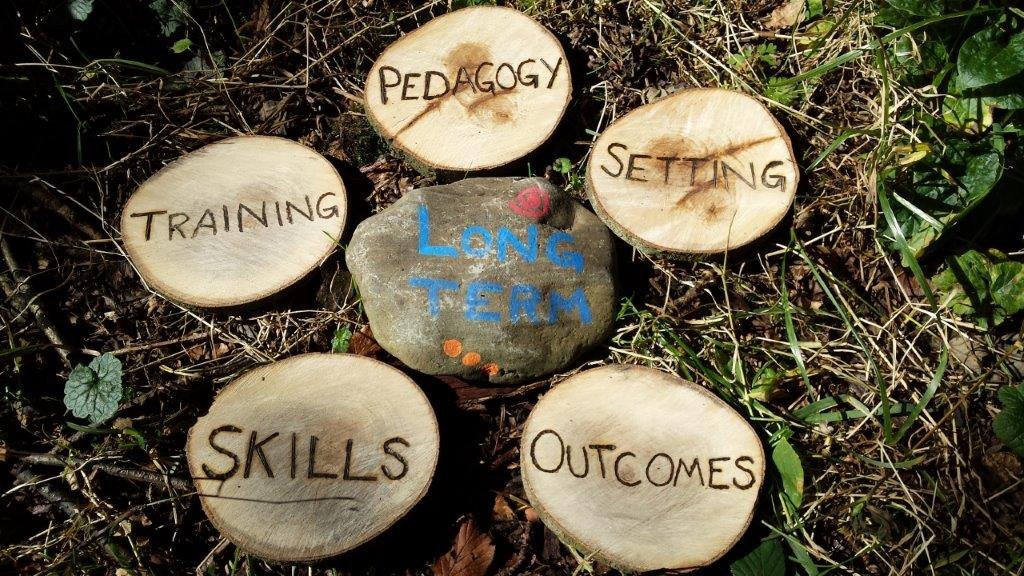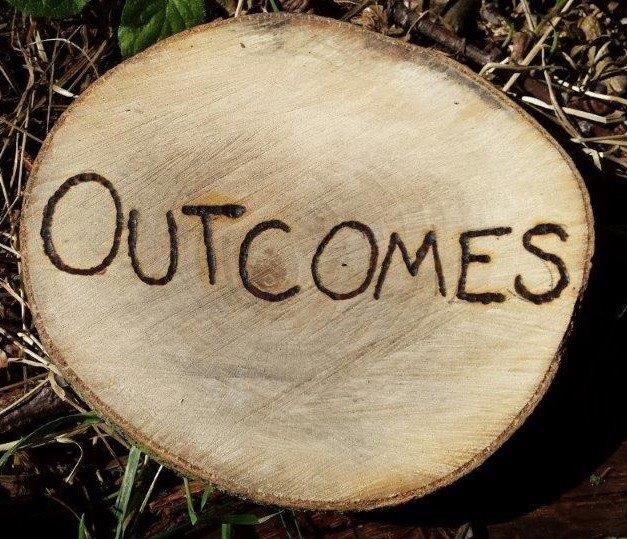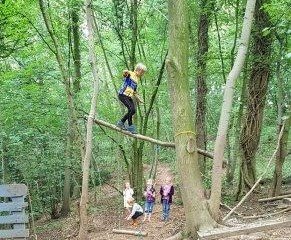Some More Thoughts on Forest School

In a previous post I discussed some initial thoughts on the Forest School approach and ended with the Forest School Association’s definition of Forest School. In this post I’ll delve into the six elements of Forest School, as they were presented during my practitioner training, whilst considering the Forest School Association’s principles of practice and relating these to the definition.
Prior to doing this, it’s worth revisiting the definition:
‘[…] an inspirational process, that offers ALL learners regular opportunities to achieve and develop confidence and self-esteem through hands-on learning experiences in a woodland or natural environment with trees’
(Forest School Association, 2018)

The six elements of the Forest School approach are the: Setting; Pedagogy; Training; Skills; Outcomes and Long-term nature of the approach. As you can see in the picture to the right, we can see there are five elements which has the sixth, the Long-term nature of the approach, at its centre. However, we can also think of them in the order we see below- that each element builds on the previous one, and the sum of these elements leads to the Outcomes for those who engage in the approach. Let’s consider each of the elements in turn…
1. Setting

The setting is primarily woodland- here lies the thing- the setting is wonderful! It has such a varied and rich supply of resources, it changes with the seasons, throughout the day and with the weather- the uses of a stick, for example, can change with a sprinkle of imagination. Children, young people and adults can explore, run, hide, jump, dig, paddle, climb, float, balance and shout. There’s no rules associated with being inside the walls of a classroom. This element represents the principle that ‘Forest School takes place in a woodland or natural environment to support the development of a relationship between the learner and the natural world’. It is here that we also see the huge benefits of nature, wildlife and wilderness can have- the setting is not only evident within the title of the approach, but also the definition: ‘woodland or natural environment with trees’. If not a woodland, then the number of trees is not specified, but we’ve got to question the practicality of setting a tarp up to get shelter, the branches to build dens, fuel for the fire and resources to craft with. Clearly, we can import some of these resources, but there is also benefits in playing among, recognising and using trees.
2. Pedagogy

Pedagogy is a term that is used to describe the art, science and approach to learning and teaching; wrapped within the concept of pedagogy is the theories, beliefs, psychologies, purposes and values of any application of learning, teaching or education. The principle ‘Forest School uses a range of learner-centred processes to create a community for being, development and learning’ is the one which is aligned to this element. Within the Forest School approach, there is a specific pedagogy- which is wholly distinct from any classroom-based pedagogy. Indeed, the pedagogy of Forest School involves each of these elements, and the application of the principles, as well as many theories. The learner-centred process is one that is open for discussion- within much of my practice, it is rather a learner-led approach that is adopted- because, they do what they wish to, I simply scaffold their activity and interest (whilst we’re on the subject, scaffolding is a concept associated with Vygotsky’s philosophy- interestingly, Vygotsky did not ever coin this term- it is something that has emerged since). It is in this element and principle that we can see a distinction between the practice and pedagogy of Forest School providers and classrooms within the UK education system- but that’s a political, ethical and theoretically weighty contention!
3. Training

‘Forest School is run by qualified Forest School practitioners who continuously maintain and develop their professional practice’. Now this is a debated element. Some suspect that this principle has been created in order to perpetuate the need for training. I would disagree with this sentiment: as a trained Forest School practitioner, graduate, post-graduate, Higher Education lecturer and teacher-trainer- I would not know the pedagogy, approach or values of Forest School without doing my Forest School training. Incidentally, I did my training with the truly inspirational Lily Horseman of Kindling Play and Training (follow this link to the website)- I whole-heartedly recommend Lily if you would like to do your training!
4. Skills

Now this element pertains to the learners who are attending rather than the practitioners- their skills are embodied within the Training element. The skills are many and varied. It could be the skill of using a bow saw or sheath knife; the ability to light a fire, maintain a fire or change the fire lay from one that allows the fire to tick over to one that will boil a kettle, as well as the soft-skills (personally I dislike that term…)- and one such skill that is key to Forest Skills is risk awareness, perception and management. It is within this aspect aht we can see the link to the principle: ‘Forest School offers learners the opportunity to take supported risks appropriate to the environment and to themselves’.
5. Long-term

This is my contention- that although in the picture above- the ‘Long-term’ element of Forest School is in the centre, and thereby at the heart of the elements of the approach- learners must engage with Forest School long-term before any truly lasting and meaningful outcomes will be realised. The Forest School Association are adamant: ‘Forest School is a long-term process of regular sessions, rather than a one-off or infrequent visits; the cycle of planning, observation, adaptation and review links each session’. It is this element that people often overlook. I have heard of one outdoor centre who have a Forest School session in the residential programme- trouble is, the children who attend the residential only do so for one week. I’ve heard of Forest School parties- where children go for two hours. There is a wide acceptance that a six week programme that sits within a half-term satisfies this element- granted, I have done the occasional six week programme and we can see growth and development within the young people and children who attend- but attending for six months, or around the calendar, is exponentially more beneficial!
6. Outcomes

Within the definition we see ‘develop confidence and self-esteem’ mentioned- it is this aspect that reflects the Outcomes element and the principle that: ‘Forest School aims to promote the holistic development of all those involved, fostering resilient, confident, independent and creative learners’. Firstly, there is a gulf of a difference between an outcome and an objective. An outcome is what comes out of an experience- an objective is what we intent to be learnt. In the education and Forest School context, an objective is what is defined by the teacher and what will be assessed, whilst an outcome is what naturally results from the experience. You’ll notice that the outcomes included within the definition and the principle are personal qualities, they are not knowledge that can be evidenced in an exam or a skill that can be demonstrated in a test- but thins that allow people to live a fulfilling life! Any skills or knowledge learnt at Forest School is a bonus, but also a vehicle to these quality based outcomes.

That concludes a consideration of the six elements and principles of the Forest School approach. I’d like to take a minute to consider the ‘All learners’ aspect of the definition. May people believe and talk of Forest School being confined to early years practice, the lower end of primary schools and nursery care. But then we’ve had one chap celebrate his 50th birthday during a Forest School session, as well as youth groups and young adults attending different programmes. Much of my practice is now with those who are in key stage 4 and upwards.
Finally, I’ve noticed recently people calling the approach Forest Schools- with an ‘s’ on the end, as if it’s plural; even some of the people have been those who train practitioners. For me, I was introduced to Forest School. I’m not sure if the inclusion of the ‘s’ is a conscious decision- I’m not going to lie- when I hear it, it rankles me- a bit like hearing your local supermarket being called Asdas, or Tescos. For my practice, and that of Rewilding Adventure, it’s Forest School- and it’s not taken lightly!







